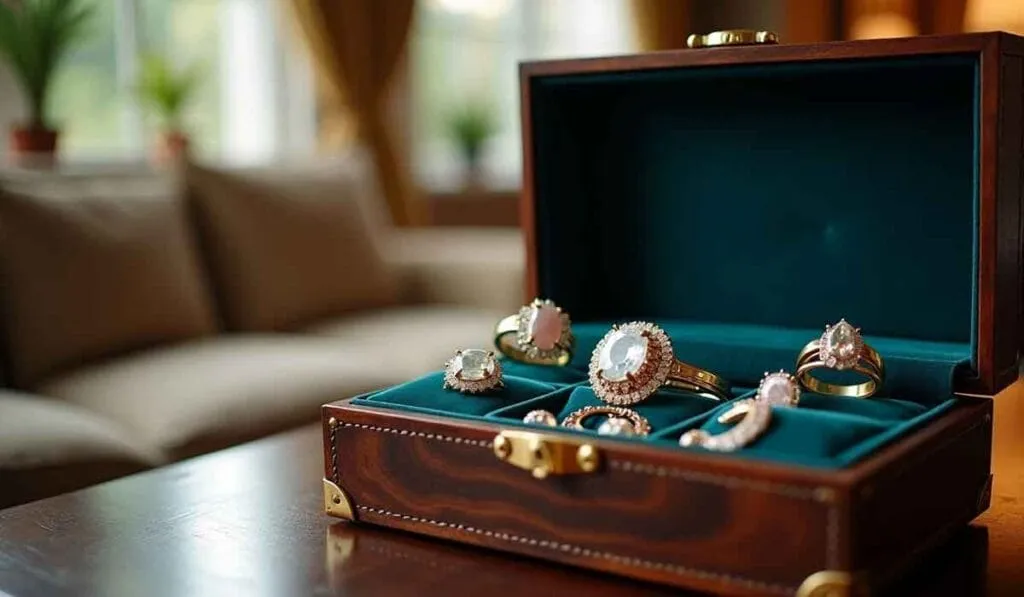
Ultimate Guide To Insuring Your Jewelry For Complete Protection
Your precious jewelry holds sentimental and monetary value.
But what if it gets lost, stolen, or damaged?
Many people ask us how to insure their jewelry properly.
Did you know that standard homeowners insurance often falls short in covering high-value items?
This guide will show you how to protect your cherished pieces fully.
Key Takeaways
- Standard homeowners insurance often has limits for jewelry coverage, typically $1,000 to $2,500 for all items.
- Scheduled personal property coverage allows you to list each piece separately, providing full-value protection for high-value jewelry.
- Standalone jewelry insurance policies offer broader protection, including worldwide coverage and protection against mysterious disappearance.
- Regular appraisals, usually every few years, help ensure your jewelry is insured for its current value.
- Storing receipts, appraisals, and detailed photos of your jewelry can speed up the claims process if needed.
Why Insuring Your Jewelry is Important

Jewelry often holds deep sentimental value and can be quite costly.
Consider your grandma’s heirloom necklace or that sparkling engagement ring. These treasures deserve excellent protection.
Insuring your jewelry safeguards against theft, loss, or damage.
Knowing you can replace or repair your precious items if something goes wrong gives you peace of mind.
Many don’t realize that standard homeowners or renters’ insurance may not fully cover high-value jewelry.
These policies often have limits for personal property, so your $5,000 diamond earrings might only be covered for $1,000.
That’s where jewelry insurance comes in.
It fills the gap, offering complete coverage specific to your unique pieces.
Plus, it typically covers mysterious disappearances – a common way jewelry goes missing.
Ensure your prized possessions have adequate coverage.
Types of Jewelry Insurance
You have several choices for protecting your jewelry.
We’ll explore the different methods to safeguard your valuable gems and metals.
Homeowners Insurance with Personal Property Coverage

Homeowners insurance often covers your jewelry but with limits.
Most policies protect personal property, including jewelry, up to a certain amount.
This coverage usually ranges from $1,000 to $2,500 for all jewelry items.
It’s a good starting point but might not be enough for valuable pieces.
Your policy may also have a per-item limit, which could be lower than the total coverage amount.
Standard homeowner’s policies typically guard against theft, fire, and some types of damage.
But they may not cover accidental loss or mysterious disappearance.
You might need to add a jewelry rider or get separate jewelry insurance for fuller protection.
Scheduled Personal Property Coverage

It’s a smart choice for high-value pieces like engagement rings or family heirlooms.
Jewelry is like the perfect spice – it always complements what’s already there. – Diane von Furstenberg
This coverage protects you against theft, loss, and damage.
It even covers mysterious disappearance.
That means you’re still covered if your ring vanishes without a trace.
Plus, you’ll often pay lower premiums compared to blanket coverage.
It’s a win-win for your wallet and your peace of mind.
Standalone Jewelry Insurance Policies

Moving beyond scheduled coverage, individual jewelry insurance offers a more comprehensive option.
These policies focus solely on your precious gems and metals, giving you broader protection designed specifically for jewelry.
Unlike add-ons to home insurance, individual policies often cover more risks.
With individual insurance, you might find higher coverage limits and fewer restrictions.
Some policies even offer worldwide protection.
This means your ring is covered at home or on a beach in Bali.
You won’t have to worry about how a jewelry claim might affect your home insurance rates.
It’s a separate policy, so your premiums stay put.
How to Insure Your Jewelry

Insuring your jewelry isn’t hard.
You must follow a few key steps to get the right coverage.
Obtain an appraisal for your jewelry
Getting an appraisal for your jewelry is crucial in the insurance process.
You need to know the true value of your pieces before you can protect them properly.
A professional jeweler or gemologist will examine your items closely.
They’ll examine factors like the quality of stones, metal purity, and craftsmanship.
This detailed assessment gives you an accurate picture of your jewelry’s worth.
An up-to-date appraisal helps you get the right amount of coverage.
Insurance companies use this information to set your policy limits.
It’s smart to get your jewelry appraised every few years.
Values can change over time due to market fluctuations.
Keep your appraisal documents safe and give copies to your insurance agent.
This way, if you ever need to make a claim, you’ll have proof of your jewelry’s worth.
Choose the type of coverage that suits your needs
You have options when picking jewelry coverage.
Start by looking at your current homeowners or renters policy.
Many offer some protection for your bling, but it might not be enough.
For pricier pieces, you may want a jewelry rider or standalone policy.
These give more complete coverage for theft, loss, and damage.
Think about what matters most to you.
Do you want a full replacement value?
Are you okay with a deductible?
How about coverage for mysterious disappearances?
Ask these questions as you shop around.
Get quotes from different insurance companies.
Compare what each policy covers and its cost.
Pick the one that best fits your needs and budget.
Review policy terms and conditions
Read your policy terms and conditions carefully.
They spell out what’s covered, what’s not, and any limits on your jewelry insurance.
Look for key details like deductibles, coverage limits, and exclusions.
Some policies might not cover certain types of loss or damage, and others may have specific rules for high-value items.
Don’t skip the fine print. It could save you headaches later.
Pay attention to claim procedures and any time limits for filing.
Some insurers require regular appraisals to keep your coverage up-to-date.
Knowing these details helps you get the most from your policy.
What Does Jewelry Insurance Cover?

Jewelry insurance can be a lifesaver when things go wrong.
It covers more than theft, giving you peace of mind for various situations.
Theft and loss
Jewelry insurance protects you from theft and loss.
Your precious gems and metals face risks every day.
Burglars might break in and swipe your baubles.
You could misplace your ring at the beach.
These scenarios happen more often than you’d think.
Good coverage steps in when the worst occurs.
It replaces your stolen or lost items, easing the financial blow.
Your policy should cover the full value of your jewelry.
Make sure it includes “mysterious disappearance” coverage.
This covers unexplained losses, like when your necklace vanishes without a trace.
Keep your policy up-to-date as jewelry values change.
Regular appraisals help you maintain the right amount of protection.
Solid insurance lets you wear your treasures worry-free, knowing you’re covered if they go missing.
Damage

Your jewelry insurance typically covers damage to your precious items.
This includes accidental drops, scratches, or even a stone falling out of its setting.
Most policies will pay for repairs or replacement if the damage is beyond fixing.
Check your policy details, though.
Some insurers might not cover damage from normal wear and tear or manufacturer defects.
Getting your jewelry fixed can be straightforward with the right coverage.
Many insurance companies work with preferred jewelers who can repair your items quickly and expertly.
If you have a standalone jewelry policy, you might even get to choose your repair shop.
Keep all receipts and documentation for any repairs you make.
This will help if you need to file a claim later.
Mysterious disappearance
Many jewelry insurance policies cover mysterious disappearance and the unexplained loss of precious gems or metals.
For example, you might put your ring down somewhere and can’t find it later.
Or your necklace could slip off without you noticing.
These scenarios fall under this category.
Most standard policies don’t include this coverage, so checking your plan’s details is crucial.
Insurance companies often require proof of ownership for claims involving mysterious disappearance.
Keep photos and detailed descriptions of your jewelry handy.
This documentation will speed up the claim process if you ever need to use it.
Tips for Protecting Your Jewelry

Your jewelry needs more than a safe spot.
Smart moves can keep your gems safe and sound.
Here are some handy tips to guard your precious pieces.
Keep receipts and appraisals
Keeping receipts and appraisals for your jewelry is crucial.
These documents serve as proof of ownership and value.
Store them safely, like in a fireproof box or a bank vault.
Digital copies can be helpful, too.
Take clear photos of each piece and save them with the paperwork.
This makes filing a claim much easier if you ever need to.
Appraisals should be updated every few years.
Jewelry values can change over time.
A recent appraisal helps you get the right amount of coverage.
It also speeds up the claims process.
Many insurance companies prefer appraisals from certified gemologists.
Ask your insurer about their preferred appraisers.
They might even offer discounts for using specific professionals.
Store jewelry securely
Now that you’ve got your paperwork in order let’s talk about keeping your bling safe.
Storing your jewelry securely is key to protecting your precious pieces.
A home safe is a great option.
It guards against theft and fire. You can also use a bank’s safety deposit box for items you don’t wear often.
These boxes offer top-notch security for your valuables.
For everyday storage, invest in a jewelry box with separate compartments.
This prevents scratches and tangling.
Please keep it in a hidden spot, away from windows and doors.
Avoid leaving jewelry out in the open, especially when you’re not home.
Thieves often target visible valuables.
By following these steps, you can help keep your jewelry safe and sound.
Take photographs of your items
After securing your jewelry, snap some pics.
This simple step can be a lifesaver if you need to make a claim.
Clear, detailed photos of your precious gems and metals are visual proof of ownership.
They also help with accurate valuation and replacement if needed.
Grab your camera or smartphone and capture each piece from different angles.
Don’t forget to zoom in on unique features or markings.
These images will be gold when dealing with your insurance company.
Plus, they’re handy for quick reference when shopping for new pieces to add to your collection.
Conclusion

You’ve got the know-how to protect your precious gems now.
Don’t wait to safeguard your sparkly treasures.
Take action today.
Get an appraisal, choose the right coverage, and keep your jewelry safe.
With the right insurance, you can wear your bling worry-free and enjoy it for years.
FAQs
Does homeowners insurance cover jewelry?
Yes, homeowners insurance typically covers jewelry, but with significant limitations. Standard policies usually have coverage limits between $1,000 and $2,500 for all jewelry items combined. These policies may also have per-item limits that could be lower than the total coverage amount. For valuable pieces, additional coverage is often necessary.
What types of jewelry insurance are available?
There are three main types of jewelry insurance:
- Standard homeowners insurance with personal property coverage
- Scheduled personal property coverage (jewelry riders)
- Standalone jewelry insurance policies
Each type offers different levels of protection, with standalone policies typically providing the most comprehensive coverage.
How much does jewelry insurance cost?
The cost of jewelry insurance varies based on several factors, including the value of your pieces, location, and coverage type you choose. Typically, annual premiums range from 1-2% of your jewelry’s value. For example, insuring a $5,000 ring might cost $50-100 per year.
What does jewelry insurance typically cover?
Jewelry insurance usually covers:
- Theft
- Loss (including mysterious disappearance)
- Damage (including accidental damage)
- Worldwide protection (with most standalone policies)
- Repairs or replacement
Some policies may also cover preventive maintenance and regular cleaning.
What is “mysterious disappearance” in jewelry insurance?
Mysterious disappearance refers to the unexplained loss of jewelry when you can’t pinpoint exactly how or where it was lost. This type of coverage is especially important for items like rings that can slip off unnoticed. While standard homeowners insurance often excludes mysterious disappearance, most specialized jewelry insurance policies cover it.
Are there any common exclusions in jewelry insurance?
Common exclusions might include:
- Normal wear and tear
- Manufacturer defects
- Intentional damage
- Loss during war or civil unrest
- Damage from insects or vermin
Always read your policy carefully to understand specific exclusions.
How do I get jewelry insurance?
To get jewelry insurance:
- Obtain a professional appraisal
- Gather documentation (receipts, photographs, certificates)
- Choose your preferred type of coverage
- Compare quotes from different insurers
- Review policy terms carefully
- Purchase the policy that best fits your needs
Why do I need a jewelry appraisal?
An appraisal is crucial because it:
- Establishes the official value of your jewelry
- Helps determine the appropriate amount of coverage
- Provides detailed documentation for claims
- Identifies unique characteristics of your pieces
- Serves as proof of ownership
Most insurers require recent appraisals (within the last 2-3 years) for valuable pieces.
How do I file a jewelry insurance claim?
To file a jewelry insurance claim:
- Contact your insurance company immediately
- Provide required documentation (appraisals, photos, police reports if applicable)
- Fill out necessary claim forms
- Work with the insurer’s approved jewelers if required
- Wait for claim approval and settlement
What’s the best way to protect jewelry and prevent claims?
To protect your jewelry:
- Store valuable pieces in a home safe or bank safety deposit box
- Take detailed photographs from multiple angles
- Keep all receipts, certificates, and appraisals
- Update appraisals every 2-3 years
- Use jewelry boxes with separate compartments to prevent damage
- Consider a home security system
How often should I update my jewelry insurance?
You should review and update your jewelry insurance:
- After any significant purchase
- Every 2-3 years for appraisal updates
- When moving to a new location
- If there are major changes in precious metal or gem prices
- After any significant modifications to existing pieces
Is my engagement ring covered under my fiancé’s insurance?
Coverage for engagement rings varies by insurer and situation. Before the wedding, the person who purchased the ring typically needs to insure it. After marriage, it can be added to a joint policy. Check with your insurance provider for specific details about engagement ring coverage.
Does jewelry insurance cover international travel?
Most standalone jewelry insurance policies offer worldwide coverage, but coverage under homeowners insurance may be limited. Always verify international coverage before traveling and consider additional protection if needed. Some policies might require notification of international travel.




